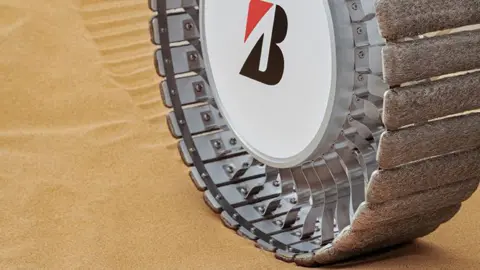Apollo’s lunar rovers used tyres made from zinc-coated piano wire in a woven mesh, with a range of around 21 miles.
Since extreme temperatures and cosmic rays break down rubber or turn it to a brittle glass, metal alloys and high-performance plastic are chief contenders for airless space tyres.
“In general, metallic or carbon fibre-based materials are used for these wheels,” says Pietro Baglion, team leader of the European Space Agency’s (ESA) Rosalind Franklin Mission, which aims to send its own rover to Mars by 2028.
One promising material is nitinol, an alloy of nickel and titanium.
“Fuse these and it makes a rubber-acting metal that can bend all these different ways, and it will always stretch back to its original shape, says Earl Patrick Cole, chief executive of The Smart Tire Company.
He calls nitinol’s flexible properties “one of the craziest things you will ever see”.
Nitinol is a potentially “revolutionary” material says Dr Padula, because the alloy also absorbs and releases energy as it changes states. It may even have solutions to heating and refrigeration, he says.
However, Mr Barthet at Michelin thinks that a material closer to a high-performance plastic will be more suitable for tyres that need to cover long distances on the Moon.
 Bridgestone
BridgestoneBridgestone has meanwhile taken a bio-mimicry approach, by making a model of the footpads of camels.
Camels have soft, fatty footpads that disperse their weight on to a wider surface area, keeping their feet from sinking into loose sandy soil.
Inspired by that, Bridgestone is using a felt-like material for its tread, while the wheel comprises thin metal spokes that can flex.
The flexing divides the lunar module’s weight into a larger contact area, so it can drive without getting stuck in the fragments of rock and dust on the Moon’s surface.
Michelin and Bridgestone are each part of different consortiums that, along with California’s Venturi Astrolab, are presenting their proposed tyre tech to Nasa at the John Glenn Centre this month (May).
Nasa is expected to make a decision later this year – it might choose one proposal or adopt elements of several of them.
Meanwhile, Michelin is testing its tyres by driving a sample rover around on a volcano near Clermont, whose powdery terrain resembles the Moon’s surface.
Bridgestone is doing the same on western Japan’s Tottori Sand Dunes.
ESA is also exploring the possibility of whether Europe might make a rover on its own for other missions, says Mr Barthet.
The work might have some useful applications here on Earth.
While working on his doctorate at the University of Southern California, Dr Cole joined a Nasa entrepreneurial programme to work on commercialising some of the technology from the Mars super-elastic rover tyre.
An early product this year will be nickel-titanium bicycle tyres.
Priced around $150 (£120) each, the tyres are much more expensive than regular ones, but would be extremely durable.
He also plans to work this year on durable tyres for motorbikes, aimed at areas with rough roads.
For all this, his “dream” remains to play a part in humanity’s return to the Moon.
“So, I can tell my kids, look up there on the Moon,” he says. “Daddy’s tyres are up there.”